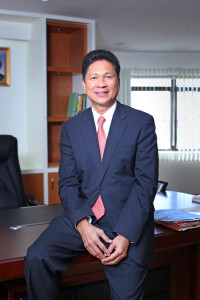Leadership
now browsing by category
Cambodia asks for original maps from UN to verify border line with Vietnam
Cambodia asks for original maps from UN to verify border line with Vietnam
Op-Ed: Xinhua
PHNOM PENH, July 6 (Xinhua) — Cambodian Prime Minister Hun Sen on Monday requested all original maps deposited at the United Nations to verify the authenticity of maps the government is using to demarcate border line with its neighboring countries.
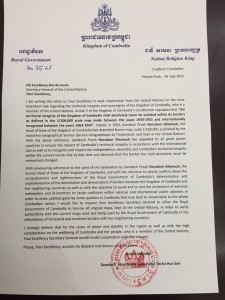 In a letter sent to UN Secretary General Ban Ki-moon, Hun Sen said, “I’d like to request Your Excellency Secretary General to allow the Royal Government of Cambodia to borrow all original maps kept at the United Nations.”
In a letter sent to UN Secretary General Ban Ki-moon, Hun Sen said, “I’d like to request Your Excellency Secretary General to allow the Royal Government of Cambodia to borrow all original maps kept at the United Nations.”
The move came after the opposition Cambodia National Rescue Party repeatedly accused the government of using the maps drawn by the Vietnamese during its occupation in the 1980s.
Hun Sen said the request for the original maps is to show the scrupulousness and righteousness of the Cambodian government in delimiting and demarcating borders between Cambodia and her neighbors.
It is also “to avoid and to end the incitement of extreme nationalism and ill-intention to cause confusion within national and international public opinions in order to make political gains by some quarters in Cambodia that may lead to catastrophe to the whole Cambodian nation,” he said.
According to the prime minister, late King Norodom Sihanouk deposited the Bonne map, scale 1/100,000, published by the Indochina Geographical Service and internationally recognized between 1963 and 1969 at the United Nations.
Border dispute between Cambodia and Vietnam flared in recent months after the opposition party lawmakers and activists inspected border line and clashed twice with Vietnamese security personnel and civilians.
Posted in Culture, Education, Leadership, Politics, Researches, Social | Comments Off on Cambodia asks for original maps from UN to verify border line with Vietnam
Tags: Border Demarcation
The scheme of borderline politics of Cambodia
 This the 6th of July 2015, Prime Minister of Cambodia, Hun Sen, wrote a letter to Ban Ki Moon, secretary general of the United Nations, to request the original copy of map Cambodia deposited since 1963 while this country became legal member of the UNs.
This the 6th of July 2015, Prime Minister of Cambodia, Hun Sen, wrote a letter to Ban Ki Moon, secretary general of the United Nations, to request the original copy of map Cambodia deposited since 1963 while this country became legal member of the UNs.
Beside of requesting the map to correctly demarcate the borderline of Cambodia with neighboring countries, the letter is directly wording “extremism and opportunist for political gain..etc” within its content.
This wording is not at ease at all as recently opposition MPs, youths, 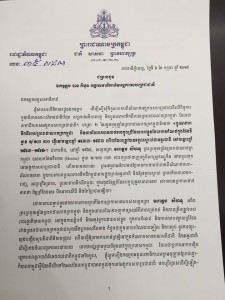 monks and farmers made several trips to the problematic checkpoints at the border between Cambodia and Vietnam. Among those violent resistances of Vietnamese people and authority, the spraying of toxic liquid destroying the Cambodian farmlands, the violence clashed in Svay Rieng, and the arresting and detaining one night of a teacher who took his students to study-trip at the border, are very outstanding.
monks and farmers made several trips to the problematic checkpoints at the border between Cambodia and Vietnam. Among those violent resistances of Vietnamese people and authority, the spraying of toxic liquid destroying the Cambodian farmlands, the violence clashed in Svay Rieng, and the arresting and detaining one night of a teacher who took his students to study-trip at the border, are very outstanding.
Nonetheless, opposition leader Sam Rainsy and Hun Sen have likely made it 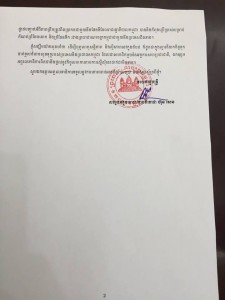 clearer and clearer to the Cambodian people and the international communities that:
clearer and clearer to the Cambodian people and the international communities that:
- The border schemes between Cambodia and neighboring countries are not opportunistic for political gain, but it is the national issue that require concerted effort to solve it.
- The new political mean of dialogue and culture of dialogue both leaders have crafted and assured the public shall emerge as the effective mean to prioritizing national interest regarding this troublesome border demarcation.
- National unity is essential for Cambodia in order to handle with the stronger and more populated neighboring countries.
- Cambodia should establish a new mechanism and new body of border committee to draw trust and transparency among the public.
- Cambodia is seeking multilateral talk with Vietnam and Thailand, if bilateral talk remains arbitrary.
- Cambodia is seeking the intervention of the UNs, the ICJ, and the signatory countries of the Paris Peace Agreement in October 23, 1991, if it is necessary.
Posted in Culture, Education, Leadership, Politics, Researches, Social | Comments Off on The scheme of borderline politics of Cambodia
Tags: Border Demarcation
Political Paradigm of Pragmatism from Khmer Youth part 26
This part of 26th volume, the author Mr. Sophan Seng described the first phase of Sun Ray Political Platform aiming to upgrade political opposition of Cambodia in implementing genuine democratic political party system like it has been practiced in civilized countries particularly Canada, Australia and the UK.
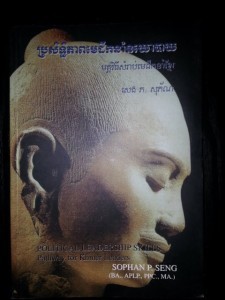 In Cambodia, the democratic development has not been inclusive since 1993 such as the inclusiveness of fair play political parties, the inclusiveness of civic engagement through civil society and bottom-line community, the inclusiveness of free and fair election committee (NEC), and the inclusiveness of responsive and effective governance leadership.
In Cambodia, the democratic development has not been inclusive since 1993 such as the inclusiveness of fair play political parties, the inclusiveness of civic engagement through civil society and bottom-line community, the inclusiveness of free and fair election committee (NEC), and the inclusiveness of responsive and effective governance leadership.
Historical remark, the political party of government leadership has enjoyed free ride since the first election result in 1993 sponsored by the United Nations. The UNs failed to establish a strong and dynamic opposition party since the beginning. The monopoly of power and resources by the political party of government leadership Cambodian People’s Party (CPP) is remained visibly tenacious. While the government and party’s affairs are not clearly separate, the opposition party(s) in Cambodia have been planned in “activism” leadership than “government” leadership.
In Canada, for instance, the opposition party is inclusive in government leadership role and this party is incentivized by several government’s sponsorship such as opposition leader and family who is minority leader of the Assembly is living in a free mansion (named Stornoway), there is official office for minority leader cabinet, minority leader can host foreign delegates regardless of their position(s), and financial support from the state to fund the researches opposition can rally the critics effectively etc.
Official Cambodia opposition party couldn’t rely on sympathy and donation in kind from supporters solely, this party can exercise their full rights within a democratic principle, the CNRP of Cambodia must be able to afford full leverages from the state budget which is owned by the Cambodian people to ensure smooth and sustainable democratization of this country.
Posted in Culture, Curriculum Vitae (CV), Economics, Education, Internet, KR Trial, Leadership, Politics, Researches, Social | Comments Off on Political Paradigm of Pragmatism from Khmer Youth part 26
Tags: Cambodia Leadership Skills, Political Leadership of Cambodia, Political Paradigm of Pragmatism
Will Cambodia Become the Gateway to ASEAN’s 600 Million Consumers?
Will Cambodia Become the Gateway to ASEAN’s 600 Million Consumers?
May 29, 2015 Asia-Pacific Cambodia
Op-Ed: Knowledge@Whorton
Selling Cambodia, a country known for its killing fields, landmines and chronic poverty, is a tough job. But Chanthol Sun, minister for commerce, says it’s very easy when “you talk from the heart.” The 59-year-old, U.S.-educated, former General Electric executive points out that Cambodia has a lot to offer to international investors: political and macroeconomic stability, a pro-business government, competitive investment incentives and a great location. Referring to the people of Cambodia as his “shareholders,” Sun says, “They have suffered long enough. It’s time for Cambodia to grow … it’s time to for us to move forward.”
Born in 1956, in Koh Thom district in the Kandal province, Sun lost his mother and brother to the Khmer Rouge. The rest of his family escaped to Thailand. In 1973, Sun went to the U.S. with $50 in his pocket. He returned to Cambodia in 1994 and helped set up the Council for the Development of Cambodia. Elected to the Cambodian National Assembly in 2003, he was the minister for public works and transport from 2004 till 2008. In September 2013, he took on his current responsibilities as minister of commerce.
In a conversation with Knowledge@Wharton, Sun talks about his faith in the future of Cambodia and what motivates him as an individual.
As edited transcript of the conversation follows.
Knowledge@Wharton: Of all the ASEAN countries, why would an investor chose Cambodia instead of, say, Thailand, Indonesia or Vietnam?
Chanthol Sun: I can give the investor a few good reasons. At the top of the list is political stability. It’s important for investors to invest in a country that is politically stable. We had a little hiccup in the elections of 2013 — the opposition boycotted the national assembly for 10 months — but that’s all sorted now. Today, politically, Cambodia is very stable.
Two, macroeconomic stability. Cambodia’s GDP has been growing at an average of 7.7% for the last 20 years. The World Bank calls us one of the ‘Olympians of growth’; [we are] the sixth fastest growing economy in the world for the last 20 years. The inflation rate is less than 5%. The exchange rate has been stable for the last 20 years. Our debt-to-GDP ratio is below 30% and our budget deficit is very small. We expect to grow at an average of 7% to 7.5% for the next five to six years.
“Foreign investors and local investors are treated equally in Cambodia.”
Third, Cambodia’s government is a pro-business government. We consider the private sector as the engine of our economic growth. We have created what we call the “technical working groups,” co-chaired by the private sector and ministers in the Cambodian government. Technical working groups on infrastructure, banking, tourism, culture, so on and so forth. These technical groups work together on a regular basis to resolve any problems that the private sector might have. If they cannot resolve these problems, they can escalate them to what we call the “government private sector forum,” chaired by our prime minster. Once a year, he invites the private sector — 300 representatives, plus the diplomatic corps, the ADB [Asian Development Bank], World Bank, IMF [International Monetary Fund] — to this forum, and they can raise any problem with the prime minister. He can make a decision right there.
IMG_0220-Four, the competitive investment incentives. Our investment laws provide very generous incentives to investors. Our corporate income tax is only 20%. There is no exchange control in Cambodia. There’s no restriction on any sector because there is no alien business law. Every economic sector is open to a foreign investor. Tell me, which country allows foreigners to own 100% banking license, 100% ownership of the telecom sector, of agriculture — every sector? Foreign investors and local investors are treated equally in Cambodia Twitter .
Last, location, location, location. Cambodia sits at the heart of ASEAN. If you get on a plane, within one-and-a-half hours’ flying time you reach 600 million consumers. When I pitch to the investors, I say, don’t come to invest only in Cambodia with its 15 million consumers. Look at ASEAN as a whole, or at least the GMS [Greater Mekong Subregion], which consists of Cambodia, Vietnam, Laos, Myanmar, and Yunnan Province [China] — that’s 220 million consumers. Or, just look at three countries, Cambodia, Vietnam and Thailand — [Cambodia is] right in the middle. So in shipping, in transportation, we could be part of the regional supply chain. We have a dynamic population — the median age of Cambodians is 24.1 — so 35 years of productive labor.
Posted in Culture, Economics, Education, Leadership, Politics, Researches, Social | Comments Off on Will Cambodia Become the Gateway to ASEAN’s 600 Million Consumers?
Tags: Sun Chanthol












